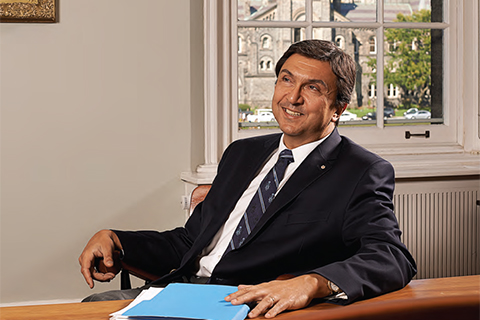Twenty years from now, the University of Toronto will mark its second centenary. The progress of the university in recent decades has been phenomenal. However, it is also essential that we take stock and lay the groundwork now for a third century of excellence here at U of T.
Consider our enrolment profile. The University of Toronto is already one of the largest public universities in North America. Over the past 10 years, the number of students at the University of Toronto at Mississauga grew 70 per cent. The University of Toronto at Scarborough grew 96 per cent; and the St. George campus grew 23 per cent. Undergraduates comprise more than 80 per cent of our enrolment today – a percentage that is sharply higher than the norm at other research-intensive universities. Some observers wonder why we have not aligned our proportion of graduate students with our research strengths. Others ask: How much growth is possible on the Scarborough and Mississauga campuses without damaging their special character? Others again wonder if the student experience on the St. George campus could be enhanced by a meaningful reduction in undergraduate enrolment.
Toronto is a remarkably diverse city that easily welcomes people from around the world. Our proportion of international students sits at around 10 per cent. Should we recruit more international students to the university? If so, how many students and from where?
It is also essential for us to re-examine our resource base. Despite recent and welcome provincial investments, Ontario remains dead last among provinces – and nearly all U.S. jurisdictions – in per-capita funding of higher education. Meanwhile, governments around the world have recognized the importance of universities as engines for innovation and have pumped billions of dollars into post-secondary education. To compete successfully, we clearly need to explore new resource strategies.
One idea is for the provincial and federal governments to adopt mission-based funding for universities. Rather than investing in all universities uniformly, the province could create distinct mandates for sets of institutions, as occurs with the California State and University of California systems, in China with its pyramidal system of post-secondary institutions, and in Germany where intense peer-reviewed competition has led to the allocation of special block funding to a small number of universities that serve as national research engines. Another less popular option would see institutions given greater flexibility in setting tuitions, provided they maintain full accessibility by offering students generous financial assistance.
Any examination of enrolment and finances has to take into account our complex tri-campus system. Our structure has evolved over 40 years to the point that the east and west campuses have developed their own distinctive programs and each serves about 10,000 students. As we look ahead, we must carefully consider roles and responsibilities across the three-campus system. Should Mississauga and Scarborough have more or less autonomy? To what extent should the academic offerings of the three campuses be differentiated?
More generally, at what point does our remarkable breadth become unsustainable, necessitating a sharper focus on specific programs of education and research? If we are going to avoid the usual trap of doing more with less, which programs will be jettisoned? Now is an excellent time to ask fundamental questions about our mission, our size and our balance.
A new report, Towards 2030, raises all of these questions and many more. The document (available at www.towards2030.utoronto.ca) is deliberately designed to encourage engagement by a wide range of readers with the big issues confronting the university for the next 25 years. Over the next few months, we will consult with U of T community members through town hall meetings, electronic forums and conversations. Our goal is to clarify some strategic directions as we approach the university’s second centenary. I strongly encourage our alumni and friends to offer their thoughts on these important questions by browsing through the document and sending comments to towards2030@utoronto.ca. Thank you in advance for your ideas and input!
Recent Posts
U of T’s 197th Birthday Quiz
Test your knowledge of all things U of T in honour of the university’s 197th anniversary on March 15!
Are Cold Plunges Good for You?
Research suggests they are, in three ways
Work Has Changed. So Have the Qualities of Good Leadership
Rapid shifts in everything from technology to employee expectations are pressuring leaders to constantly adapt






